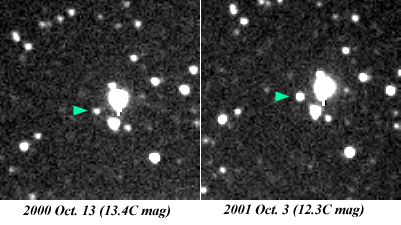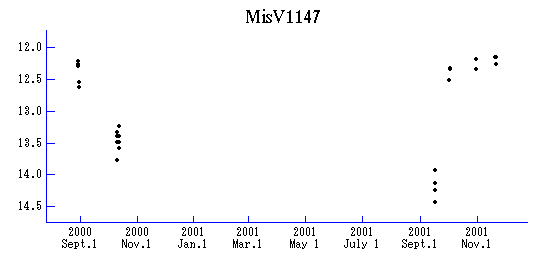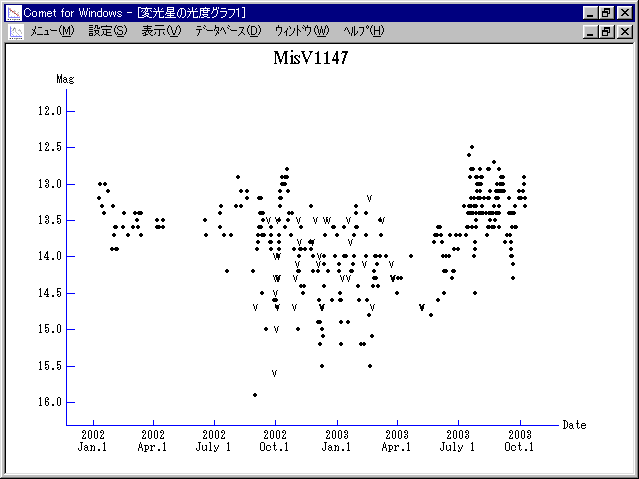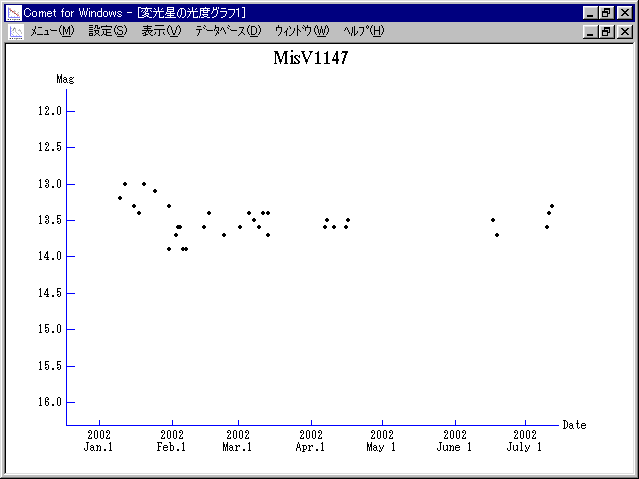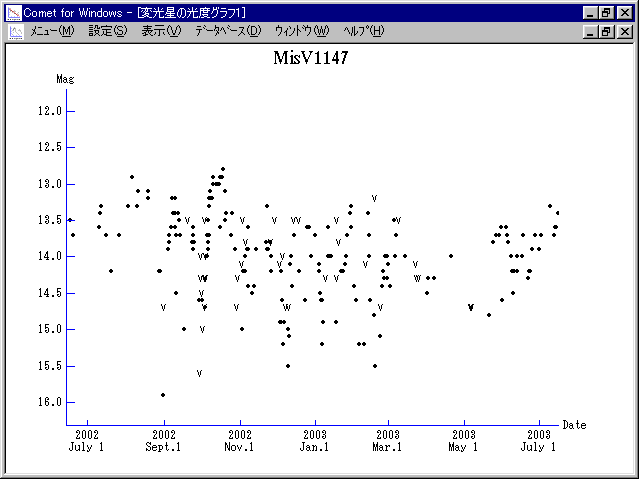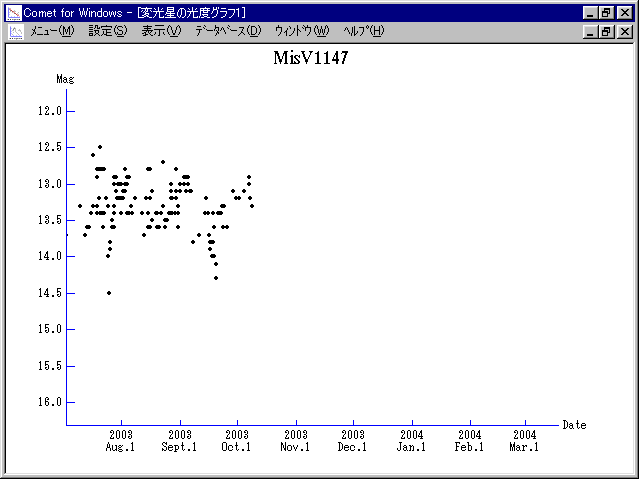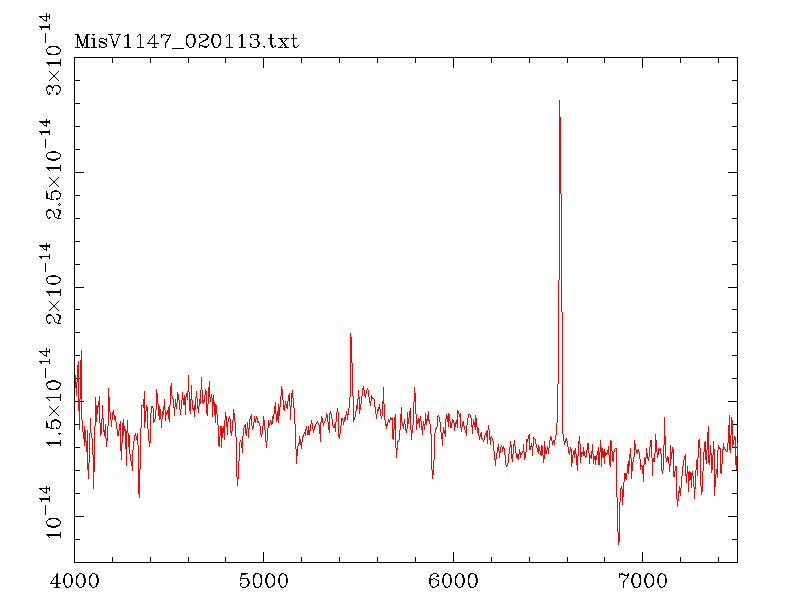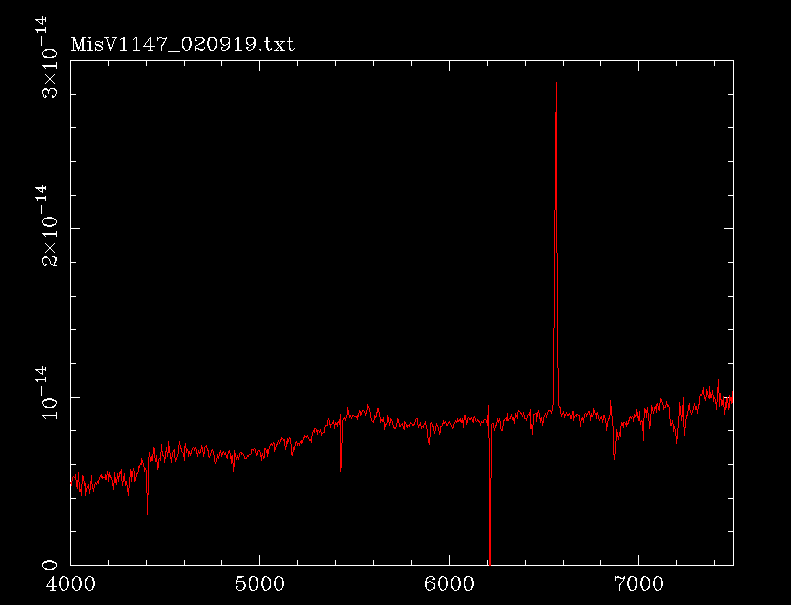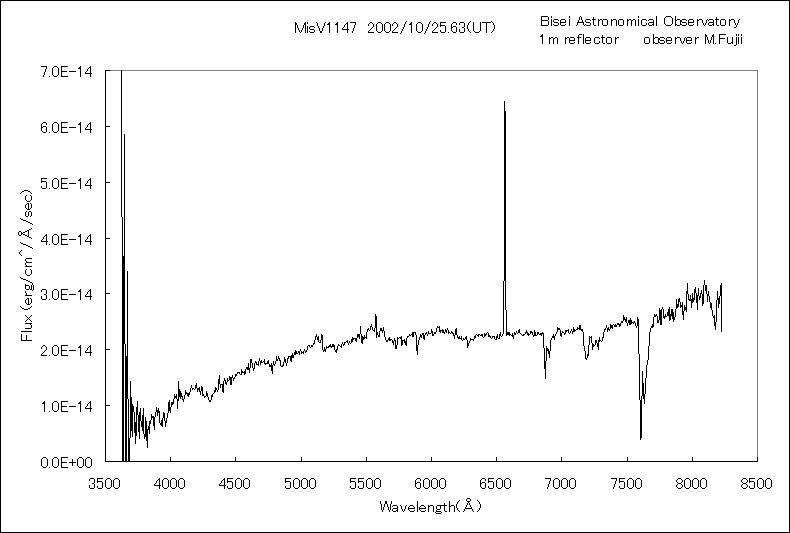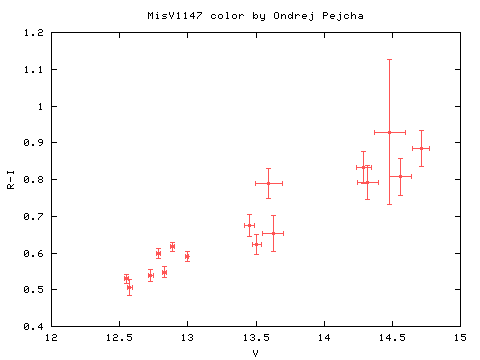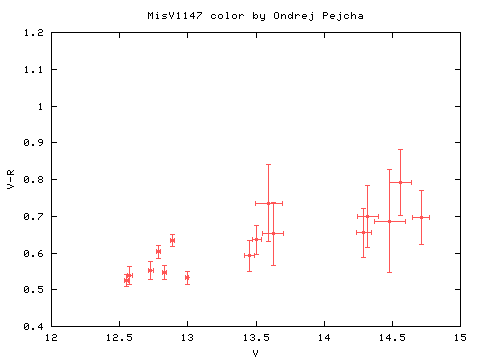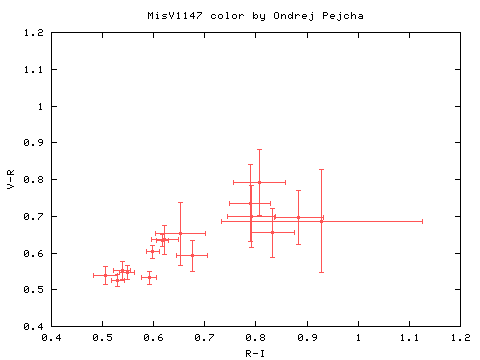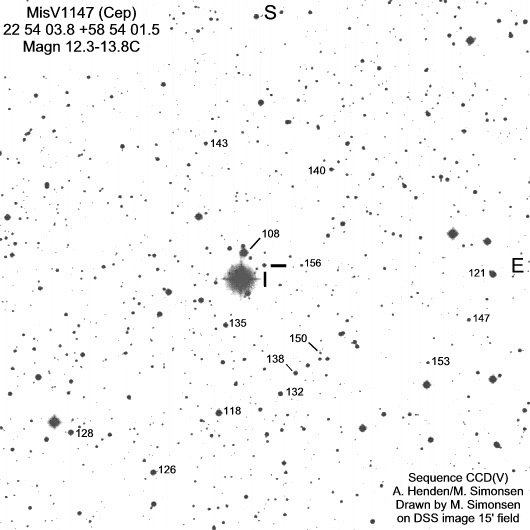Japanese version Home Page Updated on April 7, 2004
MisV1147: Young Stellar Object
|
|
| 2000 Aug. 30 | 12.3 mag | |
| Aug. 31 | 12.6 mag | |
| Oct. 11 | 13.5 mag | |
| Oct. 13 | 13.4 mag | |
| 2001 Sept.17 | 14.2 mag | |
| Oct. 2 | 12.5 mag | |
| Oct. 3 | 12.3 mag | |
| Oct. 31 | 12.2 mag | |
| Nov. 20 | 12.2 mag | |
| Nov. 21 | 12.2 mag |
It faded 0.3 mag only within 1 day between August 30 and 31 in 2000. It was extremely faint in 2001 September only, and it brightened about 2 mag only within two weeks after that.
Now it was revealed that MisV1147 shows a large amplitude variation. So the star began to attract attention of more people.
Since 2002 January, Mike Simonsen, Gary Poyner, Pavol A. Dubovsky, and other observers started monitoring of MisV1147 visually.
Mike Simonsen published the finding chart of MisV1147. He also started the MSDG observing campaign with John Greaves and other members, and requested observations of MisV1147. It is the second MSDG observing campaign on MISAO Project stars, since MisV0380.
Kenzo Kinugasa, Gunma Astronomical Observatory, took the spectrum of MisV1147 on January 13.
Arne A. Henden operated five color photometry of MisV1147 and stars in the neighborhood on January 14, and published the catalog of comparison stars to observe MisV1147.
Those observation data are available or linked from the MISAO Project Home Page.
Based on those observations, Taichi Kato pointed out that MisV1147 is probably a Herbig Ae/Be type star among young stellar objects. A star of this type is blue.
On the other hand, John Greaves suggested that MisV1147 is probably the same type as T Tauri among young stellar objects, because the five color photometry by Arne A. Henden showed the color of MisV1147 is somewhat yellow or orange.
Well, MisV1147 had been observed visually after that. But it kept around 13.5 mag and did not show any evident variation until mid 2002 July. MisV1147 had been calm in this period.
However, sudden fading of MisV1147 was captured by Mike Simonsen on July 20, 2002. Although it was 13.3 mag on July 12, it was 14.2 mag on July 20. So it faded about 1 mag. But when he observed it next time on August 3, it returned to be 13.3 mag.
Pavol A. Dubovsky had also observed it on July 16 and 26, but did not detect the fading. Only Mike Simonsen observed the faint state of MisV1147, only one night on July 20.
After that, MisV1147 was observed a bit brighter in early August, around 13.0 mag.
However, second sudden fading of MisV1147 was captured by Mike Simonsen again on August 28. In this time, Michael Poxon also confirmed the fading, so faint as 15.9 mag on August 30. It was still faint as 14.7 mag on August 31, but returned to 13 mag on September 3.
On the occasion of the second fading, Taichi Kato proposed the spectral observations. Because the spectrum taken in January is that of bright state, it is important to take the spectrum when MisV1147 is faint. So I requested to Kenzo Kinugasa and Mitsugu Fujii. But due to bad weather and the faintness of MisV1147, the spectrum could not be observed at that time.
In 2002 September, the behavior of MisV1147 completely changed. Although it had been calm until July, MisV1147 began to show frequent fadings.
Because MisV1147 became active, more people began to observe this star, Michael Poxon, Robert Stine, Kyoto University team, and many other observers.
The fading of MisV1147 looked like an eclipse, suddenly faded and soon returned. So they began to clarify the periodicity.
In late 2002 October, Taichi Kato and Chris Lloyd pointed out the rough period around 32 days. Chris Lloyd suggested that MisV1147 may be binary.
Based on the variation so far, the deep fadings down to about 15 mag for several days seemed to occur once per about one month as follows.
| around 2002 Aug. 30 |
| around 2002 Oct. 1 |
| around 2002 Nov. 1 |
| around 2002 Dec. 7 |
| around 2003 Jan. 6 |
But some other fadings have been also occurred sometimes, shallow fadings down to around 14.5 mag, or short fadings which returned within several hours.
In addition, the brightness at normal state is not constant. It was about 13.5 mag in September, but it became a bit brighter, around 13.0 mag, in October. On the other hand, it became fainter after that. It was about 14.0 mag in November, and mostly fainter than 14 mag in December.
The variation of MisV1147 seems semi-periodic, but actually complex.
At the fading in late October, Arne A. Henden operated five color photometry of MisV1147 again. Then we became to have the color information both in bright state, in January, and faint state.
The results show that the color was changed slightly reddish in faint state. But, on the contrary, the color was changed slightly bluish comparing the brightness in U-band and B-band. Taichi Kato commented that a Herbig Ae/Be type star sometimes shows such a behavior.
On September 19, Kenzo Kinugasa, Gunma Astronomical Observatory, took the spectrum of MisV1147 again. On October 25, Mitsugu Fujii took the spectrum with the 1-m telescope at Bisei Astronomical Observatory.
Taichi Kato pointed out that those spectrums also support MisV1147 is Herbig Ae/Be type, not T Tauri type. In terms of astronomy, MisV1147 is a pre-main sequence star.
Brian Skiff commented that the yellow or orange color of MisV1147 in five color photometry by Arne A. Henden is just apparent due to the interstellar absorption. MisV1147 is probably a blue B-type star without the effect.
John Greaves commented that MisV1147 looks about 3 mag fainter than real brightness due to the interstellar absorption, considering the reddening. That means MisV1147 would be 10 mag without the interstellar absorption.
John Greaves pointed out that MisV1147 is a member of the OB association named Cepheus OB1, a group of young stars. The Cepheus OB1 locates 3.5 kpc from the Earth. Assuming that MisV1147 is a B-type star, whose absolute magnitude is about -3 mag, it will be visible at 10 mag in this distance without the interstellar absorption. This coincides with the brightness of MisV1147.
By the way, the type of MisV1147 among variable stars will be "ISA", because:
- the variation is irregular.
- no nebula is observed around the star.
- it shows about 0.5 or 1.0 mag variation in short time, within several hours or days.
- it is a Herbig Ae/Be type star.
Now one year has passed since the discovery of MisV1147. Many people have been observed and researched this star. We appreciate very much. And we hope that further observations and researches will reveal much more things on this star.
Finally, two bright comets passed near by MisV1147 in 2002. Comet Ikeya-Zhang, about 4 mag, passed 57 arcmin from the star on April 18. Comet Hoenig, about 9 mag, passed only 2.5 arcmin from the star on August 5. MisV1147 may have some fateful chance with bright comets.
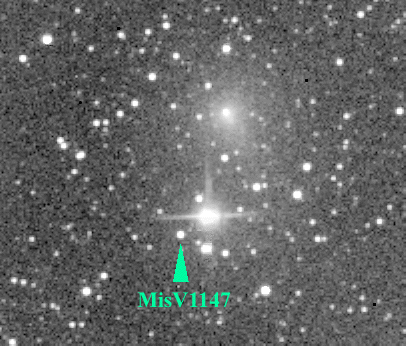
MisV1147 and Comet Hoenig (Image by Yusuke Ezaki)
|
|
|
|
|
|

